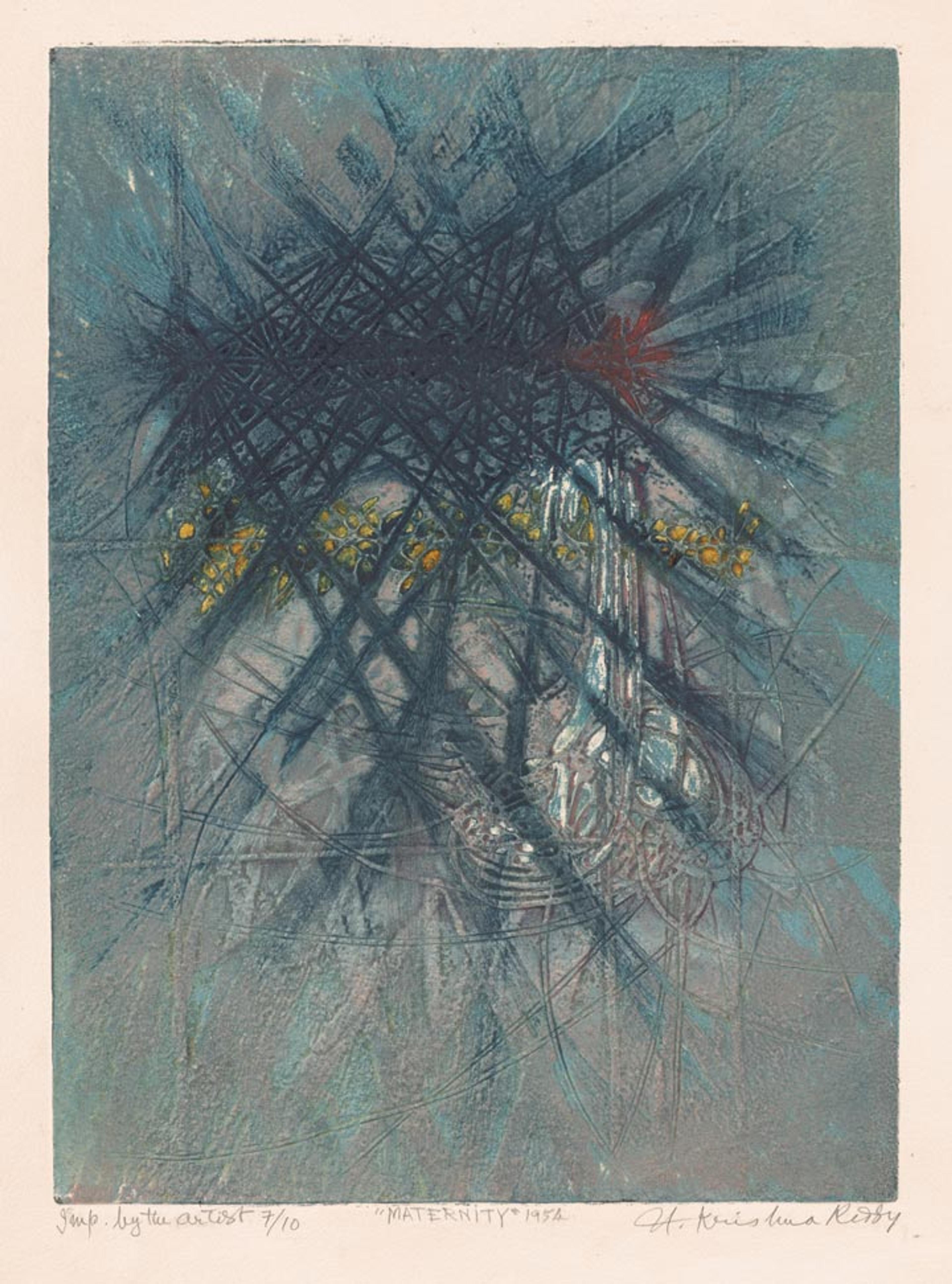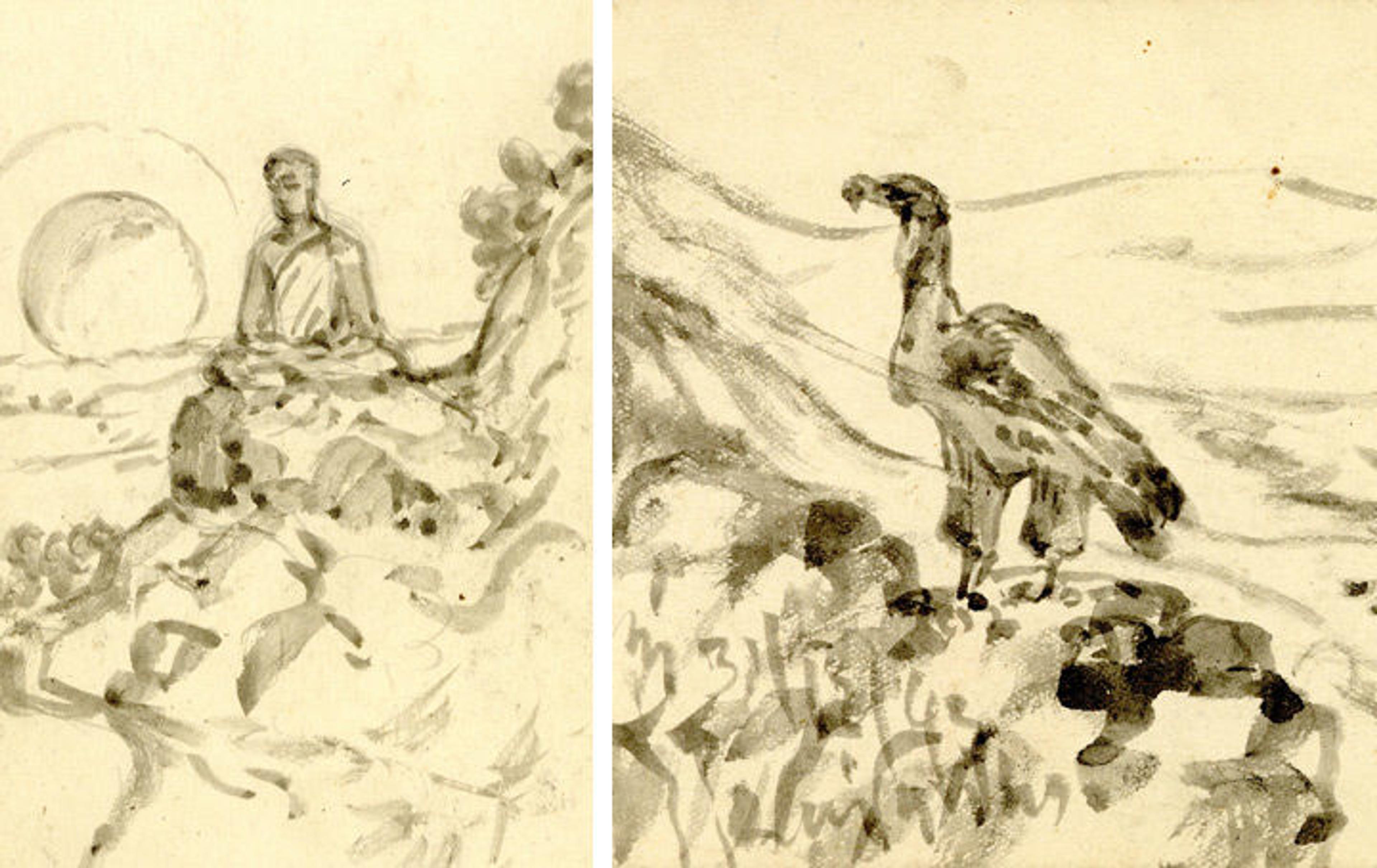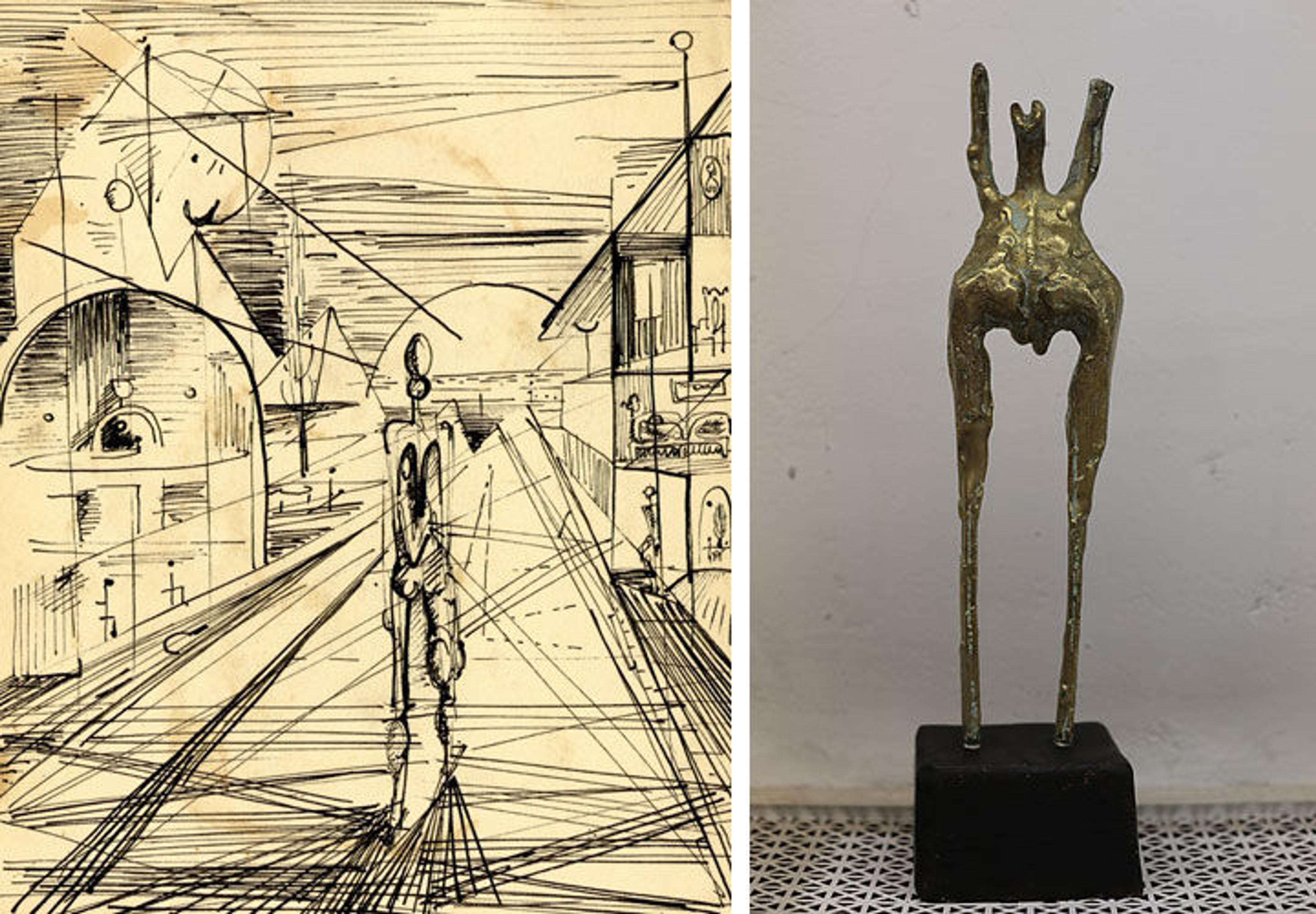
Krishna Reddy (second from left), William Stanley Hayter (center), and other artists at a café in Paris, 1950s. Photo courtesy of Krishna Reddy
«The exhibition Workshop and Legacy: Stanley William Hayter, Krishna Reddy, Zarina Hashmi—now on view through March 26, 2017—features the work of these three master printmakers who met at Hayter's Paris workshop, Atelier 17, in the 1950s. Reddy worked with Hayter at Atelier 17 to establish groundbreaking advances in viscosity printing, a type of multicolor printing that incorporates relief and intaglio print-making techniques. Reddy's education spanned varied institutions and teachers, and his early life propelled him into the work that he created in the workshop.»

Krishna Reddy (American, b. India, 1925). Maternity, 1954. Mixed color intaglio, Plate: 17 13/16 x 13 1/16 in. (45.3 x 33.1 cm), Sheet: 25 9/16 x 19 1/2 in. (65 x 49.5 cm). The Metropolitan Museum of Art, New York, John B. Turner Fund, 2014 (2014.80)
Born into a family of farmers in Chittoor, Andra Pradesh, India, in 1925, Reddy benefited from his village's proximity to the theosophical Rishi Valley School established in nearby Madanapaelle by the philosopher Jiddu Krishnamurti (1895–1986). Krishnamurti's teachings remained a strong spiritual and intellectual influence in Reddy's life, one that was never keen on artistic narcissism, but rather viewed art as a collaborative practice.
As a young man Reddy was involved in the Quit India Movement initiated by Mahatma Gandhi, which demanded an end to British rule in India. In fleeing the colonial police for his involvement in this revolutionary movement, Reddy came to Santiniketan, West Bengal, where he spent his formative years at Visva-Bharati University's Kala Bhavana (Institute of Fine Arts) founded by Nobel Laureate Rabindranath Tagore (1861–1941). While at Santiniketan, Reddy trained to be a sculptor and watercolorist, and came to be influenced by key figures such as Nandalal Bose (1882–1966), Ram Kinker Baij (1906–1980), and Benode Behari Mukherjee (1904–1980)—artists now characterized as forming the school of contextual modernism in India.

Detail views of two works created by Krishna Reddy at Santiniketan, ca. 1946. Photos courtesy of Krishna Reddy
Reddy continued his education in Europe at the Slade School of Fine Art at University College London, where he studied under Henry Moore (1898–1986) and Lucian Freud (1922–2011). In 1953 he received a scholarship to study sculpture in Paris under the Russia-born sculptor Ossip Zadkine (1890–1967), and it was there that he met Hayter, a British scientist and inventor of print-making techniques. Reddy joined Atelier 17, a thriving workshop where an uncountable number of artists were able to visit and experiment with their practices, including Joan Miró, Pablo Picasso, Alberto Giacometti, Juan Cardenas, Constantin Brancusi, and Zarina Hashmi.
It was at this time that Reddy wrote about his artistic ideas in his notebooks, where he displayed an eagerness to articulate his understanding of art. An excerpt from these notebooks is reproduced below.
Excerpt from the Notebooks of Krishna Reddy, Paris, 1950s

Three pages from one of Krishna Reddy's notebooks used in the 1950s. Photo courtesy of Krishna Reddy
"A New Form"
The same way as the sound transforms into light waves through a medium, the visual form if expressed spontaneously in any medium like in words, music, colour, stone, metal, etc., a completely new form results. For the working process of nature cannot be initiated by our expressing the same experience through plastic mediums.
Not a screw we turned in these dark periods, whereas in the West, the artist, the philosopher, the scientist, and the common man walked hand in hand answering the problems of man in one way or the other. While our great men went into caves to meditate. We do not want a paradise, in this age, but we need a healthy man. For that we have become aware of the mistakes of the Western man in trying to be happy, has created a psychologically sick man. There the artist, the scientist, the philosopher, and the common man have got confused—for the machine is enslaving them. Why not we learn a lesson and create a healthy surrounding where a healthy man can grow and live a creative life—be a flute of the great nature that surrounds us.
Great forces are churning this earth, creating this cream of vast unknown forms of nature, and we are left to wonder and if possible calculate this with our own limited mind. When one stopped measuring we see man like a flute in Nature's hands and we experience a bit of that vast unknown. Ah! To be that flute!
If the tree, standing on the earth, is real to our eyes and the image of the tree with all its roots, we know of, radiating like the sun's rays—from the seed to the flowers—is real, why not the whole being of the tree—the whole machinery, the cells, the molecules, the atom, and the whole structure that we have understood be revealed. To see the flame of the tree radiating like a fountain, so are nature's every form and the space itself. Like the dance of the Nataraja, space beats out a form and the form creates space.
To think of this part of the earth where we live, a special region indeed, with more colour, more light, more varieties of forms of nature, and more wealth, what we made of this land—a grand miserable slum by day—with the few who do not want to part their so-called long-loved freedom—leaving the big populations in a utter misery and sickness. We have been that way for thousands of years or more, enslaved and twisted with disease—never have we grown in those thousand years—but in number we have grown from 2 crores (20 million) to 40 crores (400 million), not a screw we turned out as a society.
How can the common man understand the artist of today? It is the question they ask me every day. True, they have gone apart—and that is the problem to be solved. The critic, instead of being the educator of the masses, is involved in creating a personality out of the artist with commercial outlooks, the common man condemning the artist for not pleasing his eyes and psychological needs; and the artist to be creative and to investigate is involved in his own satisfaction, he is the product of a sick society. His nervous hands not under control or his mind wandering away as his suppressed desires run amuck—so his work of art is full of confusion.
This vicious circle is the problem of today—in order that the common man, the critic, and the artist to be in time with each other—we need to work together for a healthy atmosphere to create healthy men on this fast-rolling earth—for us to stop and investigate during our short-lived lives—a white ant that was born today to die tomorrow—and yet sing in tune with this unknown universe.

Left: Krishna Reddy (American, b. India, 1925). A New Form, 1950s. Photo courtesy of the artist. Right: Krishna Reddy (American, b. India, 1925). Untitled/"Demonstration" with Single Figure, 1968. Cast bronze, Height: 16 in. (40.6 cm), Width: 4 in. (10.2 cm), Depth: 4 in. (10.2 cm). On loan from the artist
Related Links
Workshop and Legacy: Stanley William Hayter, Krishna Reddy, Zarina Hashmi, on view at The Met Fifth Avenue through March 26, 2017
The Artist Project, Season 6: "Krishna Reddy on Henry Moore"